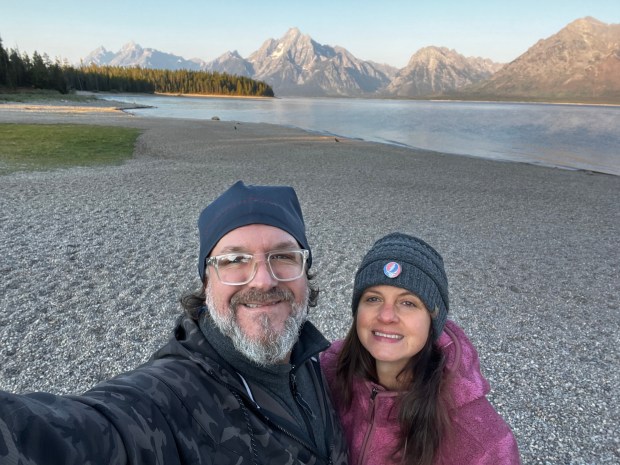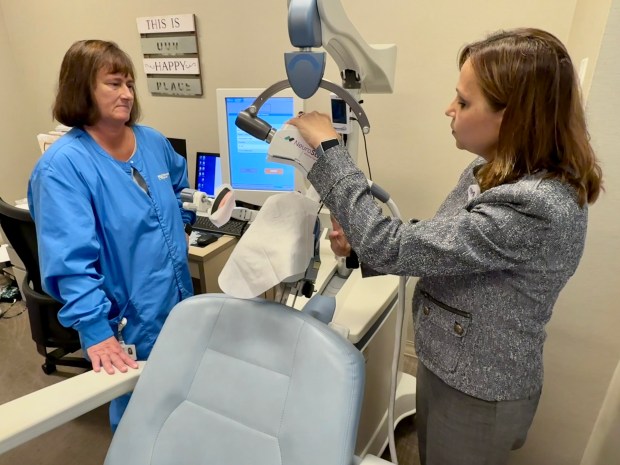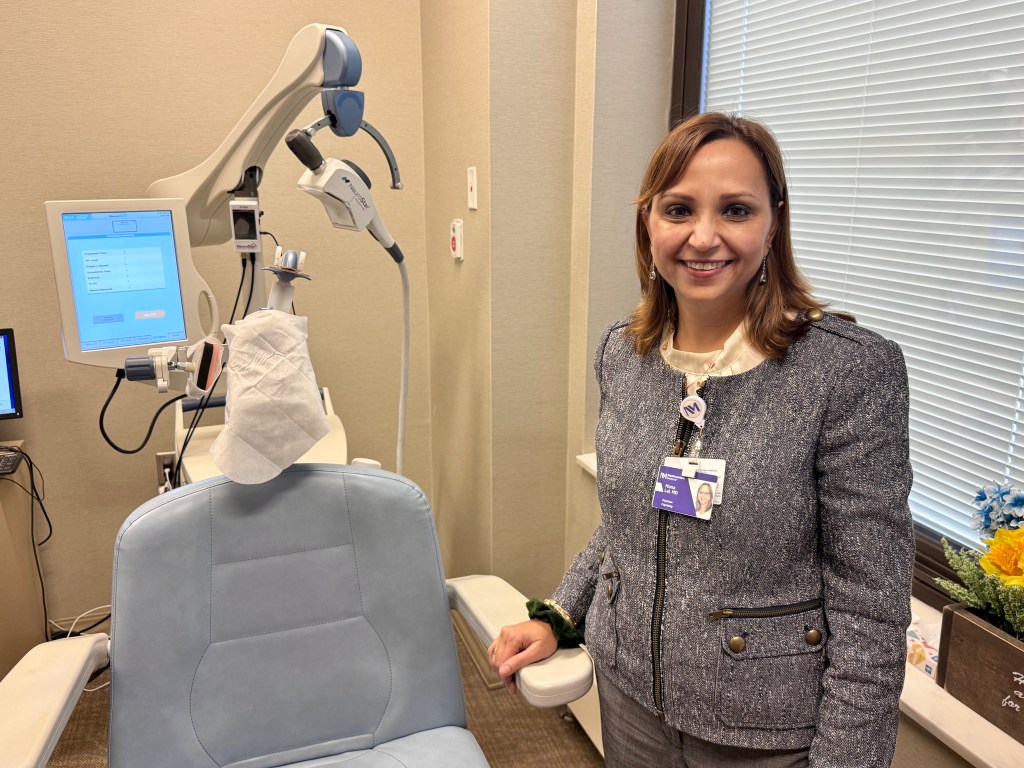Sarah Praski makes no secret that she sometimes struggles with her mental health, and she’s just as open about what helped with her treatment-resistant depression: transcranial magnetic stimulation, or TMS, done at Northwestern Medicine Palos Hospital in Palos Park.
The Tinley Park resident had anxiety as a child and had taken medication for the condition since she was diagnosed at 18 with general anxiety disorder. But two intense personal losses – her fiancé dying in 2009 when Praski was 31 and her dad dying by suicide three years later – led to severe depression. “They were the loves of my life, so the two traumatic losses back to back, that was that,” she shared.
She suspects a change in her hormones a few years ago led to her getting treatment-resistant depression, or TRD. The medications she’d been taking no longer were working, and her life dramatically changed.
“It was really bad. I went from being able to manage a lot of different tasks at once and keep everything in order in my head to having to write everything down and not recalling things. So memory loss, brain fog, really bad,” Praski said. “And the physical sensation of depression? Pure exhaustion. Having a hard time getting out of bed. And my anxiety was so bad, just in the last couple of years, I couldn’t go to the grocery store by myself. I had to have my husband or mom with me because I was agoraphobic.”
Her condition led to her taking leaves of absence from her job in continuing medical education at Northwestern Medicine Hospital, which she’s had for 16 years, working initially at the downtown location but transferring to the Palos Park site after she moved to Tinley Park.
When Praski’s doctor retired, Dr. Mona Lal became her psychiatrist, seeing her as an inpatient before the TMS treatment. “We were at the point where I was seeing her once a week, and now I see her every four months,” she said. “So that’s the difference of being better.”
It was Lal who told her about TMS. “I had heard about it and read about it. I didn’t even know it was at Palos,” Praski shared, despite her working at the hospital. “Dr. Lal said ‘Why don’t we try this?’”
Being treated in Palos Park made the process easier. “You can drive afterward, but it’s nice to have someone with you,” she said of the daily sessions. “My mom doesn’t go downtown, so finding out it was accessible at Palos was a dream come true.”
Praski had the initial series of 36 sessions, followed by another series the following year to gain remission. “Some people do it and never have to do it again, and some people have to do it again. It just depends on your case,” she said. “You have to take care of yourself. It’s not an easy fix. You have to get sunlight, eat well and don’t isolate. All those things are still important.”
She said other people saw the changes treatment brought before she did. “A lot of people were telling me I seem more like myself. Everything seems bright – you notice more things. You’re not in a cloud of despair. I went on a vacation this spring. It was my first vacation in forever, and I remember telling my mom ‘There’s no way I could have done this 12 months ago.’ I couldn’t have gotten on an airplane.”
 Sarah Praski, of Tinley Park, who developed treatment-resistant depression, and her husband, Michael Praski, take a selfie at Yellowstone National Park. “Michael was so loving. It’s not easy to be with someone experiencing a mental health crisis because you feel so helpless,” she said. (Michael Praski)
Sarah Praski, of Tinley Park, who developed treatment-resistant depression, and her husband, Michael Praski, take a selfie at Yellowstone National Park. “Michael was so loving. It’s not easy to be with someone experiencing a mental health crisis because you feel so helpless,” she said. (Michael Praski)
Praski said her family is thankful for the treatments. “They probably get down on their hands and knees thanking Dr. Lal that their wife, friend, cousin is back.”
TRD is diagnosed “when patients have received at least two adequate trials of antidepression medications and psychotherapy has been attempted,” said Lal, a board-certified psychiatrist who treats adults. “This is standard treatment for major depressive disorder.”
TMS is not an automatic option for some struggling with TRD. “If patients are acutely suicidal or acutely psychotic or manic, then they need more treatment interventions and TMS is not indicated. They need to be stabilized first,” Lal explained.
In addition, patients must be able to commit to the number of sessions. “There are 36 treatments that last for about 20 minutes. You are able to drive yourself back and forth to the treatment, so you have to come three to five times a week for six to eight weeks.”
Treatment involves a device that delivers pulse magnetic fields and is pointed at the region of the brain that causes depression. Lal said the treatment activates “neural circuits which are underactive in patients with depression. … That is how patients respond without taking any medication systemically and preventing side effects from that.”
She called it an “innovative, new treatment, relatively speaking; a neuromodulation process. This treatment does not involve any anesthesia (unlike electroconvulsive therapy, or ECT). The patient is awake and aware of all the treatment.”
People who have metal close to the treatment area, such as a deep brain stimulator, cochlear implant or tattoo with metallic ink, can’t use the treatment because of the magnetic field.
 Registered nurse Gina Panka, left, and Dr. Mona Lal adjust a machine used for transcranial magnetic stimulation, or TMS, to help patients with treatment-resistant depression at Northwestern Medicine Palos Hospital in Palos Park. (Northwestern Medicine)
Registered nurse Gina Panka, left, and Dr. Mona Lal adjust a machine used for transcranial magnetic stimulation, or TMS, to help patients with treatment-resistant depression at Northwestern Medicine Palos Hospital in Palos Park. (Northwestern Medicine)
At the initial session, Lal and her TMS practitioner, registered nurse Gina Panka, go through a mapping process to locate the exact location on the patient’s scalp “so we can identify the energy, the power, the amount of energy given through the treatment coil.”
Once the patient is seated in a chair similar to those in a dental office, the tech places the patient’s head in position and the doctor places the magnetic coil gently against the left side of the person’s head, Lal said.
That process takes 30 to 40 minutes, and then the first treatment is given. Following sessions last about 20 minutes.
Patients typically feel a tapping sensation in the area, similar to getting an MRI. “The typical sensation they describe is like a woodpecker: tap, tap, tap, tap,” Lal said, adding that earplugs can help with the noise, as well as taking over-the-counter pain relievers.
Praski called the treatment room “calm,” adding that sessions aren’t painful “but it takes a little while to get used to it because it’s really loud. … I’m sure some people would maybe say it’s a little scary at first. You can just sit there and talk, whatever you want to do,” she said.
TMS has few side effects, which is one reason Lal likes the treatment.
“Some headaches have been reported in people but it does get better,” she said. “There have been reported seizures in clinical trials and the risk is 1 in 30,000 treatments, or 1 in 1,000 patients, so we screen for high-risk patients. … But so far, touch wood, we have not had any episodes since 2017. It’s really rare.”
From 2017 to now, the Northwestern Medicine Behavioral Health Services team at Palos Hospital has treated about 150 patients with TMS therapy. Those interested in learning more can call 708-923-5772.
Lal said her patients have seen good results with TMS, and she hopes potential patients and physicians in the area become aware of this option to treat depression.
“A lot of my patients will talk after about 10 or 15 treatments … they feel like a brain fog has been lifted. They will tell me they are starting to think more clearly. They will talk about their energy levels being better,” she said. “They’re talking more about smiling more. They’re interacting more with their families and loved ones and getting their life back. These are the statements I hear from patients.”
Praski urged people to explore the treatment option. “There’s no shame in struggling with mental health. The world is a hard place right now. Reach out in whatever avenue you can find. It’s not your cross to bear alone,” she said. “There are so many resources, and if you’re experiencing treatment-resistant depression, I would highly recommend exploring TMS because it’s not invasive. It’s life-changing.”
Melinda Moore is a freelance reporter for the Daily Southtown.
Originally Published: October 6, 2025 at 5:02 AM CDT

